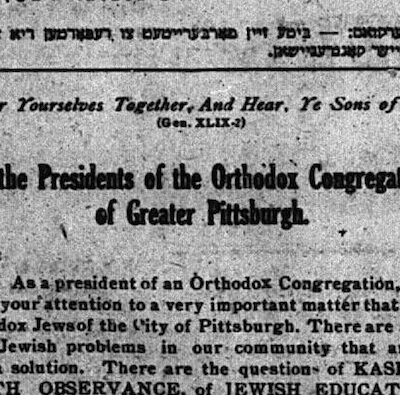
The Agudath Kehillath, or Union of Orthodox Hebrew Congregations, was an attempt to unify and standardize Jewish religious observance throughout the greater Pittsburgh area. Following a previous attempt in the early 20th century, the Agudath Kehillath was formed in December 1920 under the chairmanship of Rabbi Sol B. Friedman of Poale Zedeck Congregation.[1]“To The Presidents of the Orthodox Congregations of Greater Pittsburgh,” Der Volksfreund, Dec. 24, 1920 (online).
Over the course of its existence, the union included delegates from the following Orthodox and Conservative congregations throughout the Greater Pittsburgh area: Adath Israel Congregation of Oakland, Adath Jeshurun Congregation of the East End, Congregation Ahavas Achim of Carnegie, Ahavas Achim Congregation of McKees Rocks, Ahavath Achim Congregation of Oakland, Congregation Ahavas Sholem Anshe Lubovitz, Anshe Lubovitz Congregation, Beth El Congregation, Beth Hamedrash Hagodol Congregation, Beth Israel Congregation of Allegheny, Beth Jacob Congregation, Beth Mogen David Congregation, Congregation Beth Shalom, Beth Yehuda Congregation of Manchester, B’nai Israel Congregation of the East End, the Butler Street Congregation of Lawrenceville, Chofetz Chaim Congregation, Cneseth Israel Congregation, Homestead Hebrew Congregation, Kahal Chassidim, Kether Torah Congregation, Machsikei Hadas Congregation, Ohev Zedeck Congregation of Oakland, Ohr Chodosh Congregation, Poale Zedeck Congregation, Shaaray Tefillah Congregation, Shaare Torah Congregation, Shaare Zedeck Congregation, Shaare Zion, Talmud Torah Congregation of the South Side, Tiphereth Israel Congregation, Torath Chaim Congregation, Tree of Life Congregation, and Z’erae Hashass of the East End.[2]Agudath Kehillath notice, Jewish Criterion, Jan. 7, 1921 (online). [3]Agudath Kehillath notice, Jewish Criterion, Nov. 18, 1921 (online). [4]Agudath Kehillath notice, Jewish Criterion, July 13, 1928 (online).
Among the priorities of the Agudath Kehillath were creating local standards for Kashrut certification, improving Jewish religious education, promoting Sabbath observance, creating a Beth Din (religious court) to adjudicate intracommunal disputes, addressing complaints of discrimination made by Jewish employees, counteracting Christian missionaries in the city, and other issues related to Jewish religious observances.[5]Agudath Kehillath notice, Jewish Criterion, Jan. 14, 1921 (online).
Rabbi Friedman left the Agudath Kehillath in November 1921 following internal disputes.[6]Cong. Poale Zedeck notice, Jewish Criterion, Nov. 25, 1921 (online). The Agudath Kehillath remained active through 1922 and was instrumental in keeping Rabbi Aaron Mordechai Ashinsky from leaving Pittsburgh in 1922 but ultimately dissolved in 1923. Rabbi Friedman re-organized the Agudath Kehillath in June 1928.[7]Agudath Kehillath notice, Jewish Criterion, June 8, 1928 (online). It was again short lived and soon evolved into the Orthodox Rabbinical Assembly.
References
| ↑1 | “To The Presidents of the Orthodox Congregations of Greater Pittsburgh,” Der Volksfreund, Dec. 24, 1920 (online). |
|---|---|
| ↑2 | Agudath Kehillath notice, Jewish Criterion, Jan. 7, 1921 (online). |
| ↑3 | Agudath Kehillath notice, Jewish Criterion, Nov. 18, 1921 (online). |
| ↑4 | Agudath Kehillath notice, Jewish Criterion, July 13, 1928 (online). |
| ↑5 | Agudath Kehillath notice, Jewish Criterion, Jan. 14, 1921 (online). |
| ↑6 | Cong. Poale Zedeck notice, Jewish Criterion, Nov. 25, 1921 (online). |
| ↑7 | Agudath Kehillath notice, Jewish Criterion, June 8, 1928 (online). |